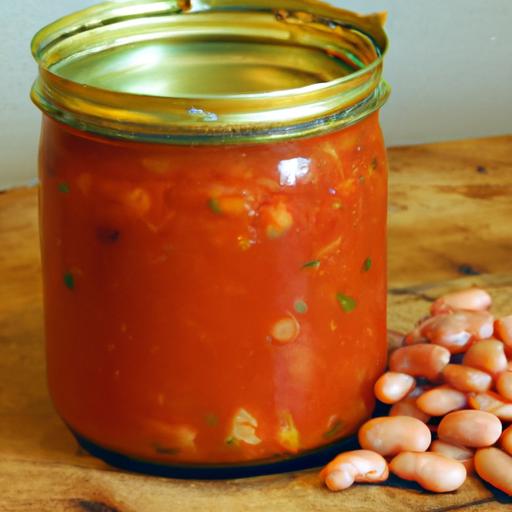There’s something unmistakably off about a sauce that tastes “canned”-that slightly metallic tang, the flatness, the lingering artificial notes that rob a dish of its homemade charm. But why does this happen? What mysterious alchemy turns vibrant tomatoes, rich herbs, and spices into something that feels mass-produced and bottled in a factory? In this article, we’ll unravel the secrets behind that elusive “canned” flavor, exploring everything from ingredient choices and preservation methods to the subtle chemistry lurking in your pantry staples. Get ready to sharpen your taste buds and discover how to transform your sauce from factory-floor bland to fresh-from-the-garden fabulous.
Why does my sauce taste “canned”? This common culinary conundrum often stems from the nuanced interplay of preservatives, packaging, and cooking methods that subtly shape the flavor profile of store-bought sauces. Understanding these factors empowers home cooks to transform a seemingly flat, canned-tasting sauce into a vibrant, fresh masterpiece bursting with rich aromas and layers of flavor.
Prep and Cook Time
- Preparation Time: 10 minutes
- Cooking Time: 25 minutes
Yield
Serves 4
Difficulty Level
Easy to Medium
Ingredients
- 1 jar (24 oz) store-bought tomato sauce (choose a low-sodium, preservative-free option if possible)
- 2 tbsp extra-virgin olive oil
- 1 small onion, finely chopped
- 3 cloves garlic, minced
- 1 tsp sugar (to balance acidity)
- 1 tsp dried oregano or fresh chopped herbs
- Fresh basil leaves for garnish
- Salt and freshly ground black pepper, to taste
- Pinch of red pepper flakes (optional, for depth)
- ½ cup dry red wine or vegetable broth
Instructions
- Heat olive oil in a wide skillet over medium heat. Add finely chopped onion and sauté until translucent and golden, about 5 minutes, stirring regularly to prevent burning.
- Add minced garlic and cook for an additional 1 minute, releasing its fragrant aroma without browning.
- Pour in the jar of tomato sauce and stir to combine. Let it simmer on low heat for 10 minutes to mellow and blend flavors, stirring occasionally.
- Stir in sugar, dried oregano, and a pinch of red pepper flakes if using. This helps mask any metallic or overly preserved taste often caused by can liners or additives.
- Deglaze the pan with red wine or vegetable broth, scraping the bottom to lift any caramelized bits. This adds complexity and freshness, transforming the canned notes.
- Season with salt and fresh ground pepper to taste. Keep simmering for an additional 5 minutes until the sauce thickens slightly and tastes balanced.
- Turn off the heat and stir in a handful of fresh basil. The herbaceous freshness cuts through any remaining canned flavor, brightening the sauce beautifully.
Chef’s Notes: Tips for Success
- Choose Wisely: The Focus Keyword sensation of canned flavors often stems from preservatives like sulfites and packaging materials. Opt for glass jars or BPA-free packaging to reduce this effect.
- Cook Low and Slow: Gentle simmering allows chemical preservatives to evaporate or blend into the sauce. Rushing this process risks preserving the “canned” edge.
- Add Acidity & Sweetness: A touch of sugar balances harsh acidity, while a splash of balsamic vinegar or lemon juice can further brighten the sauce.
- Fresh Herbs & Aromatics: Incorporate freshly chopped herbs, garlic, or even a sautéed carrot to add natural sweetness and counteract processed flavors.
- Freeze Leftovers: Store any transformed sauce in airtight containers for up to 3 days or freeze in portions to preserve freshness.
Serving Suggestions
Serve this revitalized sauce over freshly cooked pasta, spooned generously alongside garlic-roasted vegetables, or as a base for homemade pizza. Garnish with torn fresh basil leaves, a sprinkle of grated Parmesan, or a drizzle of extra virgin olive oil to showcase the fresh, vibrant transformation from canned to crave-worthy.
| Nutrient | Per Serving |
|---|---|
| Calories | 140 kcal |
| Protein | 3 g |
| Carbohydrates | 18 g |
| Fat | 7 g |

Learn more about mastering sauces with our detailed guide on homemade tomato sauces. For scientific insights into preservatives and packaging impact, see ScienceDaily’s article on food packaging effects.
Q&A
Q&A: Why Does My Sauce Taste “Canned”? Unpacking the Flavor
Q1: What does it mean when a sauce tastes “canned”?
A: When a sauce tastes “canned,” it often has a flat, overly acidic, or metallic flavor reminiscent of something preserved in a tin can rather than fresh ingredients. It can feel one-dimensional, lacking the brightness and complexity you’d expect from homemade or freshly prepared sauces.
Q2: Why do some sauces develop that canned flavor?
A: The “canned” taste usually comes from the cooking process or the ingredients themselves. Canned tomatoes, for instance, contain preservatives like citric acid or calcium chloride that can contribute to that tangy, metallic note. Overcooking can also concentrate acidity and dull vibrant flavors, reinforcing that canned impression.
Q3: Is the metallic or acidic flavor harmful?
A: Not at all. Those bright, tangy notes come from natural acids and additives that preserve the sauce’s shelf life and prevent spoilage. While they might not be unpleasant, they can overwhelm delicate flavors and make a sauce taste less fresh.
Q4: How can I avoid the canned taste in my sauces?
A: Start by balancing acidity with a pinch of sugar or a splash of cream to round out sharp edges. Using fresh tomatoes when possible, or supplementing canned ones with fresh herbs, garlic, and a touch of olive oil, can enhance depth and reduce the “canned” vibe. Also, avoid overcooking-gentle simmering helps preserve brightness.
Q5: Are there certain types of sauces more prone to the canned flavor?
A: Tomato-based sauces are the usual suspects because tomatoes are often canned or concentrated. But any sauce made with preserved ingredients-like jarred pasta sauces, canned peppers, or even some premade condiments-can carry similar undertones.
Q6: Can I embrace the canned flavor intentionally?
A: Absolutely! Some classic dishes rely on that distinctive tang and acidity for authenticity, like certain rustic stews or quick weeknight pasta sauces. The key is to balance and layer flavors so the “canned” notes add character rather than overpower.
Q7: What role does acidity play in that canned taste?
A: Acidity is often the flavor culprit-it brightens a sauce but can also make it sharp and biting if unchecked. Canned tomatoes have a naturally higher acid level than fresh ones, which is essential for preservation but can become pronounced during cooking.
Q8: Does the type of can impact flavor?
A: Modern cans are lined with food-safe coatings to prevent metallic tastes, but sometimes small traces of metal or the acidity interacting with the lining can contribute subtle off-flavors. Storage time and temperature can also affect this.
Q9: How do professional chefs tackle the canned flavor?
A: Chefs often balance acidity with sweetness, salt, fat, or umami-rich ingredients like mushrooms, anchovies, or aged cheese. Fresh aromatics and finishing with herbs or a drizzle of quality olive oil can also elevate flavors beyond the preserved base.
Q10: In summary, why does my sauce taste canned-and what’s the secret to fixing it?
A: Your sauce tastes canned because of the natural preservatives, acidity, and sometimes cooking method or ingredient quality. The secret is to balance and brighten: a pinch of sugar, a splash of cream or olive oil, fresh herbs, and mindful simmering transform that flat, sharp “canned” note into a lively, layered flavor that feels homemade and fresh.
In Conclusion
In the end, that unmistakable “canned” flavor isn’t just a culinary quirk-it’s a story of preservation, processing, and pantry practicality. By understanding the ingredients, cooking methods, and storage secrets that shape your sauce’s taste, you can transform a jarred staple into a vibrant, fresh-feeling experience. So next time your sauce whispers those tin-can notes, remember: with a pinch of savvy and a dash of creativity, you hold the power to turn humble convenience into homemade magic.


